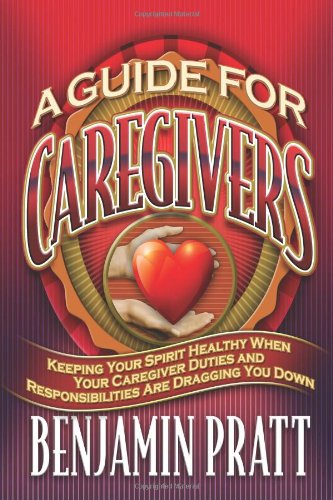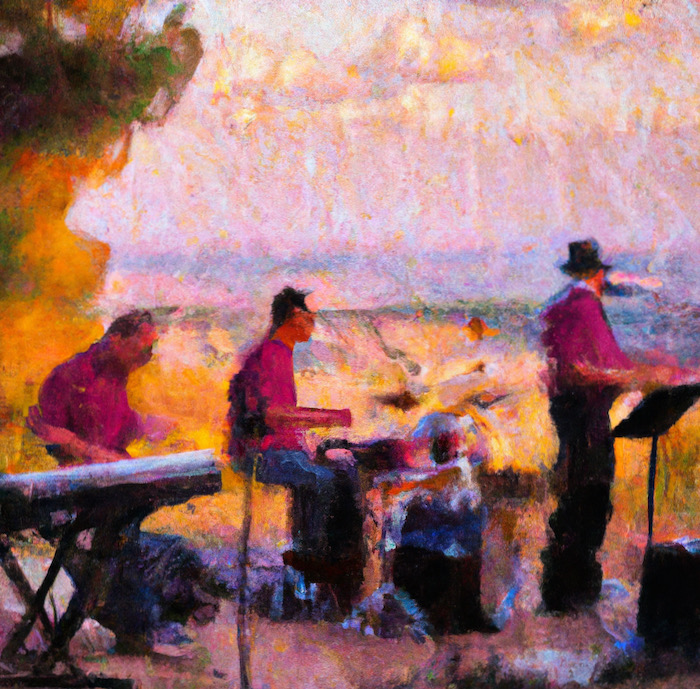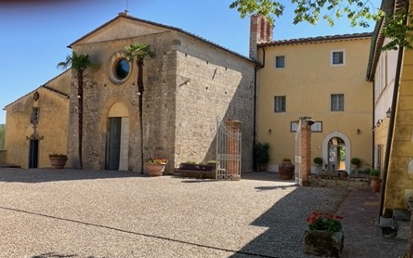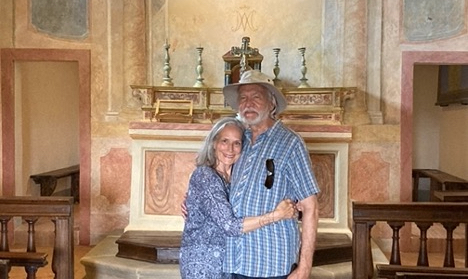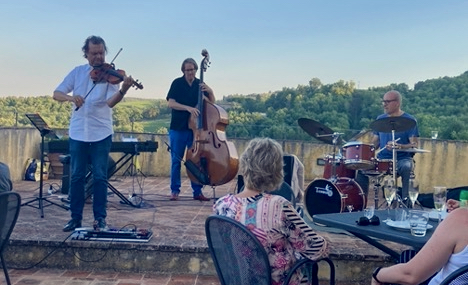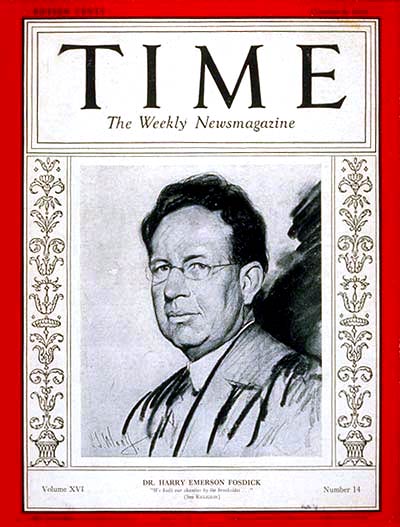
Fosdick was so famous—his critics at the time called him “infamous” for his prophetic preaching—that he was featured on TIME magazine’s cover in 1925 (the image shown on our front page this week) and again in 1930 as shown here. Both of these cover images are now out of copyright and in public domain, according to Wikimedia Commons.
By BENJAMIN PRATT
Author of Short Stuff from a Tall Guy
As I laid down my daily newspaper the other day, recoiling from one more report about racially motivated violence, I thought:
This is why we need prophets.
I’m talking about prophets in our biblical tradition, men and women who dare to stand up and name the evils in our contemporary culture and remind us of a different way to live.
Think for just a moment about this question: How long has it been since you heard a sermon about sin? Yes, there are many sermons preached about greed, moral cowardice, self-righteousness, snobbery—the list of ills is long. But how often have you heard them referenced as sins? I suspect we are anxious about using that word today, because it reminds us perhaps of a fire-and-brimstone style of preaching that often is more toxic than truly motivating.
Yet, I don’t think I’m alone in reacting to the weekly litany of hate crimes by wishing that more prophetic voices were raised in all houses of worship nationwide to clearly name the sins of racism that continue to dominate American life. I say “all houses of worship” here because this particular sin has often been named in historically Black churches. What I wish we could hear was a more unified choir of voices of all color lifting up and naming this struggle.
You may think that prophets, motivated by our religious traditions, are irrelevant today. After all, one in four Americans now say they don’t have a personal religious affiliation. Millions of Americans seem to be abandoning religious authority. But, in fact, prophetic voices from many religious traditions continue to make a huge difference in lives around the world. That’s why my column that you’re reading right now is paired with this week’s ReadTheSpirit Cover Story on the prophetic work of Dr. David Gushee.
Or, you can read earlier stories in our magazine about the prophetic work of George A. Mason, Rabbi Lenore Bohm, Mallory McDuff or Daneen Akers.
These voices can be powerful, can move people to change their hearts, to re-engage in our society in helpful new ways.
A tradition in our American history
In this column, I want to remind readers that this tradition is longer than you might imagine in American history. One prominent voice against our sin of American racism was raised by the lead pastor at Riverside Church, New York: the Rev. Dr. Harry Emerson Fosdick (1878-1969) who was born and reared in Buffalo, NY.
Fosdick was commissioned for the ministry in the Baptist tradition in 1903 and graduated from Union Seminary in 1904. In 1918, he was called to First Presbyterian Church in New York City, and on May 21, 1922, he delivered his famous sermon Shall the Fundamentalists Win? In that prophetic sermon, he presented the Bible as a record of the unfolding of God’s will, not as the literal Word of God. He saw the history of Christianity as one of development, progress, and gradual change.
Just last year, as Russia’s attack on Ukraine began, historian Diana Butler Bass recalled the relevance of that sermon, which she described as “one of the most important and influential sermons of the 20th century.” She related that 1922 sermon to current debates within Orthodox churches over the war in Ukraine. (The Presbyterian Church USA’s digital archive has the text of Fosdick’s entire sermon online.)
After that sermon, many of Fosdick’s Presbyterian colleagues were so angry that they forced him to defend himself in a church trial. His defense was led by none other than John Foster Dulles, who later became U.S. Secretary of State. As a result of the furor, Fosdick won a new ally in John D. Rockefeller Jr. and became the first pastor of the historic, liberal, inter-denominational Riverside Church, Manhattan, in 1930.
Naming the Sin of Racism
Fosdick never wavered in his prophetic calling. During World War II, he preached a message naming the sin of racism that was collected in a now out-of-print book he called, A Great Time to be Alive; Sermons on Christianity in Wartime.
It’s well worth re-reading a portion of that message today to remind us of our collective calling as Christian leaders. Here’s an excerpt:
“We, the democracies, are likely to reap a terrific harvest from our racial sins.
“Moreover, the whole world knows how little democracy means to us when it comes to the racial line within our own nation. I get letters from people in this city filled with antisemitic hatred so dreadful that Hitler himself could hardly improve on it. In one of our states today there is a large and lovely lake, and on that lake a camp including both white and colored soldiers, equally ready to die for their country. A friend of mine has seen ten thousand of those soldiers swimming at one time in that lake, but no Negro was among them. Owing to local prejudice, the military authorities dare not allow a colored man to enter the water.
“Far from being an isolated phenomenon, this is symbolic of an intolerable situation affecting nearly one-tenth of the population of the United States. No section of the country is free from blame. Whether it be Jim Crow segregation, the closing of hotels and restaurants to Negroes, the refusal to address them as Mr. or Miss or Mrs., accosting them only by their given names, the denial to them of equality before the law, at the ballot box, and in educational opportunity, or the restriction of their employment to certain narrow fields regardless of their abilities, North and South alike we must rethink our attitude toward the Negro if we are not to make a farce of our democracy.
“And nowhere is this more true than in our churches where often it is sheer hypocrisy to read from the New Testament: ‘There cannot be Greek and Jew, circumcision and uncircumcision, barbarian, Scythian, bondman, freeman; but Christ is all, and in all.’
“Do not waste your moral failure; it is deplorable, but don’t waste it; it need not be a total loss; not only can you escape from it but you can make use of it. The Apostle Paul himself started as a persecutor of the church. I never read this thirteenth chapter of I Corinthians on love without seeing those blood-stained hands of his writing it. That violence of his against the Christians was an awful sin; he suffered agony about it but he learned something from it so profound and moving that when he wrote about the opposite of violence, love, he said something unforgettable that no ordinary man could ever have said.
“Paul’s moral failure was not wasted.
“If someone protests that it is dangerous doctrine to say that sin can be put to good uses, I answer: No! Just because trouble can be used to great ends nobody goes out looking for it, and just because sin can be transmuted into gain, no one will plunge into it. To make a huge blunder, to land in a Far Country, to suffer shame’s agony, and then to have to come again, saying, “I am no more worthy to be called thy son”—no man in his senses will go out looking for that. But when trouble and moral failure come—and they do come to all of us—don’t waste them!
“The greatest characters of history have been, as it were, born out of the travail of the sense of shame.”
Energy for the journey ahead
As I read Fosdick’s words so many decades later, I still feel that charge he lays out so powerfully in the language of his era. The core of his indictment is as valid today as it ever was.
Surely, our work of combatting racism in our country and world is a long road ahead. May we encourage each other—and prophetically energize each other—along this journey.

